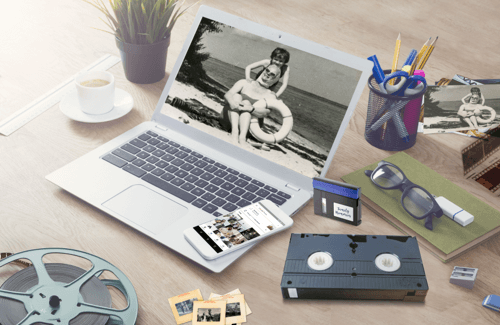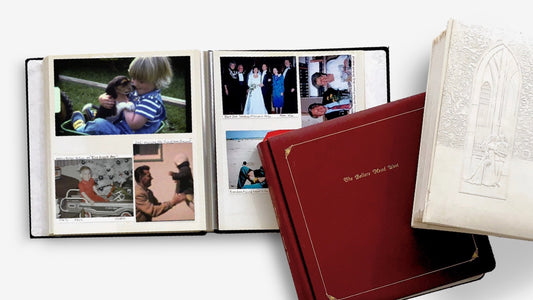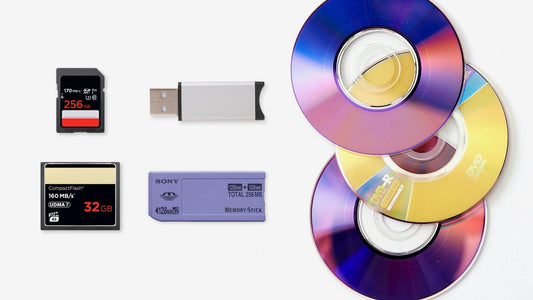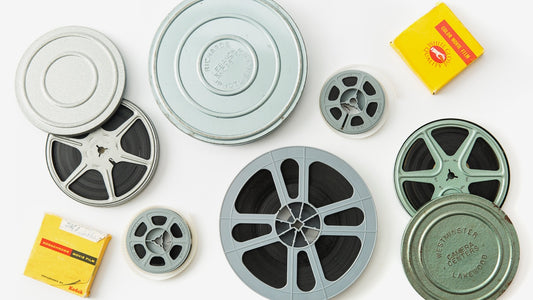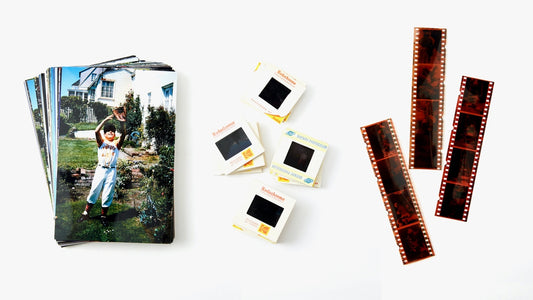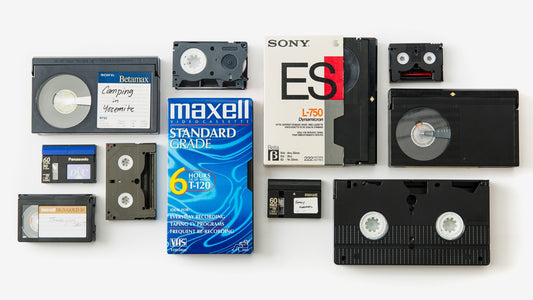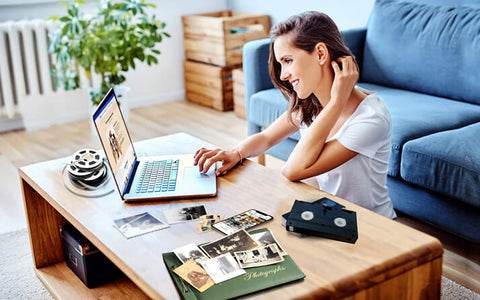That box of old tapes in the attic is a ticking clock. Those tapes aren't just plastic; they're time capsules holding the voices and laughter of people you love. But the magnetic film they're stored on is slowly fading, taking your family’s memories with it. The good news is you can stop this decay. Learning how to restore old video is about more than just converting files—it’s about preserving your story. This guide will walk you through how to bring those moments back to life, ensuring they can be shared for years to come.
Key Takeaways
- Your Tapes Have an Expiration Date: Old video tapes and film reels weren't made to last and are slowly losing their quality. Digitizing them is the only way to stop this natural decay and safeguard your family's history for good.
- Choose Your Restoration Path: Decide whether a DIY project or a professional service is right for you. Going DIY offers creative control but requires time and technical skill, while a professional service provides expert handling and peace of mind for your most precious or damaged media.
- Protect Your Digital Memories: Once your videos are digitized, the job isn't over. Create a simple backup plan by keeping copies on both a physical external hard drive and a cloud storage service to ensure your memories are safe from any single point of failure.
Why Restore Your Old Home Movies?
If you’ve ever stumbled upon a box of old home movies in your attic, you know that feeling of hitting a historical jackpot. Those tapes hold priceless moments: birthday parties from the 90s, your parents' wedding, or just a regular summer day in the backyard. But here's the thing about those tapes—they weren't made to last forever. The magnetic tape inside them is slowly fading, and with it, the memories they contain.
Restoring your old home movies is about more than just fixing a few glitches. It’s about stopping the clock on their decay and preserving your family’s story for generations to come. By converting them to a digital format, you make them permanent, shareable, and easy to enjoy all over again. It’s a way to bring those moments back to life and ensure they’re never lost to time.
Why Your Video Tapes Are Fading Away
Think of your old video tapes like old photographs; they degrade over time. Formats like VHS, 8mm, and Super 8 film are physical media, and they are incredibly vulnerable to their environment. The magnetic tape that stores the picture and sound can weaken from exposure to heat, humidity, and even the Earth's magnetic field. Over the years, this causes the colors to fade, the audio to warp, and the overall image quality to decline.
The tapes themselves can also become brittle and fragile. Each time you play an old tape, you're risking a snap or a tangle, which can cause permanent damage. That’s why a professional video transfer is so important—it safely captures the footage before it’s lost for good.
The 15-Year Lifespan of a VHS Tape
It’s a hard truth, but those tapes weren't built to last. Most experts agree that formats like VHS, MiniDV, and 8mm film start to show significant signs of decay after about 15 years. The magnetic tape that holds the video and audio information is incredibly fragile. Over time, it simply begins to break down. Common culprits like dust, mold, and even just how the tapes were stored can speed up this process, causing the picture to get fuzzy and the sound to become distorted. Every year that passes makes the tape more vulnerable, putting those irreplaceable memories at risk.
It’s not just physical damage you have to worry about. Environmental factors like light and magnetic fields also contribute to the breakdown of old tapes and film reels. This is why digitizing your collection is so crucial. A professional film transfer service can safely handle these delicate materials, capturing the footage before it degrades any further. By converting your home movies to a digital format, you create a permanent, high-quality copy that is safe from the physical decay that threatens the originals, ensuring your family's history is preserved for good.
How to Tell if Your Videos Are Degrading
You don’t need to be a video expert to spot the signs of a fading tape. The clues are often visible to the naked eye or audible as soon as you press play. Look for things like color distortion, where the picture has a strange tint or the colors seem to bleed into each other. You might also notice the audio sounds muffled, fuzzy, or has a persistent hum that wasn't there before.
Sometimes, you can see the damage on the tape itself without even playing it. Check for visible wear, like wrinkles or creases in the tape. In damp storage conditions, mold can even begin to grow on the film. These are all clear indicators that your tapes are in urgent need of preservation.
Keeping Your Family's Story Alive
Beyond the technical reasons, restoring old videos is about holding onto what matters most. These recordings are irreplaceable windows into your family’s past. They capture the voices, laughter, and mannerisms of loved ones, preserving personal histories in a way that photos alone can't. Digitizing these moments ensures they are protected from fires, floods, or simple decay.
Once your memories are in a digital format, they become incredibly easy to share. You can send a clip of your grandparents' wedding to your entire family with a single click or create a highlight reel for a special birthday. Services that handle film transfer make it possible to pass these precious moments down to your children and grandchildren, keeping your family’s legacy alive and accessible for everyone to enjoy.
What Kind of Old Video Tapes Do You Have?
Before you can bring your family memories into the digital age, you first need to know what you’re working with. Tucked away in attics and basements are decades of different video formats, each with its own quirks. Understanding the type of tapes you have is the first step in the preservation process. It helps you figure out what equipment you’d need for a DIY project or what to tell a professional service.
Different formats require different players, and some are more prone to damage than others. Taking a moment to identify your collection will save you time and potential heartache down the road. Think of it as a little treasure hunt—you might be surprised by what you find!
From VHS to Hi8: A Quick ID Guide
Let's start by playing detective with your media collection. Most home movies from the ’80s and ’90s are on a few common types of tapes. The most recognizable is the VHS, the chunky black rectangle that was a staple in every living room. You might also find its smaller cousin, the VHS-C, which fits into an adapter to play in a standard VCR. Other popular formats include 8mm, Hi8, and Digital8 tapes, which are all similar in size to an audio cassette. MiniDV tapes are even smaller and were common in the late ’90s and early 2000s. If you need help figuring out what you have, YesVideo’s video transfer service page has a great visual guide to all the formats they can digitize.
What's Actually Happening Inside Your Tapes?
Video tapes were never meant to be a forever format. They are made of magnetic tape, a delicate material that naturally breaks down over the years. Think of it like an old photograph that fades in the sun—your tapes are slowly losing their picture and sound quality just by sitting on a shelf. This process is often called "tape rot." Environmental factors can speed up this decline. Humidity can cause the tape’s binding layers to break down, while extreme temperatures can make the tape brittle. Even storing them near electronics like speakers or a TV can be damaging, as magnetic fields can erase parts of your footage. This is why it’s so important to digitize your memories before they fade away completely. The same goes for older media like film reels, which also require careful film transfer to preserve.
What to Check Before You Restore Your Videos
Before you get excited and pop a tape into an old VCR, take a moment to inspect it for damage. Playing a compromised tape can permanently destroy your footage and break your player. Look closely at the cassette itself. Do you see any cracks in the plastic shell? Check the small window for any signs of white or black spots, which could be mold. Mold not only ruins the tape but can also spread to your equipment. Also, check the tape itself. If it looks wrinkled, twisted, or feels brittle, it’s a sign of physical damage. If the tape is snapped, it will need to be professionally repaired before it can be played. Trying to fix these issues at home is risky without the right tools and expertise. If you see any of these warning signs, it’s best to set the tape aside for a professional service that handles both video digitization and photo transfer.
Hiring a Pro? Here's What to Expect
Handing over a box of your family’s most precious memories can feel like a big step, but choosing a professional service is often the safest and most effective way to preserve them. When you work with experts, you’re not just paying for a digital file; you’re investing in their experience, specialized equipment, and a process designed to protect your originals. They understand the sentimental value of what you're sending and treat each tape, reel, and photo with the care it deserves.
Unlike a DIY project, which can be a gamble with irreplaceable tapes, a professional service has the right tools and knowledge to handle fragile and aging media. They know how to clean, repair, and carefully convert your home movies, ensuring the best possible outcome. This approach saves you time and the stress of potentially damaging a tape forever, giving you peace of mind that your videos are in capable hands. From the moment you send your tapes in, a team of technicians takes over, using their skills to bring your memories back to life for you and your family to enjoy for years to come.
What Do You Actually Get for Your Money?
At its core, a professional restoration service is designed to convert your old media into modern digital formats. The first step is finding a company that can handle your specific tapes or film reels. A comprehensive service will begin by carefully inspecting and cleaning your media by hand to remove dust and debris that can affect quality. If they find any damage, like a snapped tape, they’ll perform necessary repairs before the transfer. The main event is the digitization itself, where they use professional-grade equipment to capture the video and audio. Afterward, you’ll receive your memories as digital files on a DVD, a USB drive, or through a cloud link, ready for easy viewing and sharing.
What Happens to Your Tapes at the Lab?
So, what actually happens to your tapes once they leave your hands? The process of video restoration is all about taking old, sometimes poor-quality recordings and making them look and sound their best in a digital format. Once your tapes arrive at the facility, they are typically labeled and tracked to ensure nothing gets lost. Technicians then begin the careful work of cleaning, repairing, and converting them. The entire process usually takes a few weeks, as each tape is handled individually to ensure the highest quality. Most orders are completed within a month, and you’ll get your original tapes back along with your new digital copies.
How YesVideo Handles Your Memories with Care
At YesVideo, we understand that we’re not just handling tapes; we’re handling your family’s history. That’s why every step of our process is designed with care. From the moment your order arrives, each tape is treated with individual attention. Our technicians begin by carefully inspecting and cleaning your media by hand, gently removing any dust or debris that could affect the final quality. If we come across any damage, like a snapped tape, our team performs the necessary repairs before the video transfer even begins. This hands-on approach is our promise to you—we’re dedicated to capturing the best possible version of your memories. Once everything is digitized, we safely package and return your original tapes right along with your new digital copies.
A Peek at Professional Restoration Technology
One of the biggest advantages of a professional service is access to technology that’s just not practical for home use. Digitizing old media correctly requires expensive, specialized equipment. For example, a professional film transfer involves scanning each tiny frame of the reel one by one to create a smooth, high-quality digital video. This level of precision is what separates a professional result from a DIY attempt. It also takes a lot of practice and skill to operate this machinery and make the right adjustments. While technicians can work wonders, it’s good to remember that some footage may be too damaged to be fully restored, but they have the best tools for the job.
How Good Will Your Restored Videos Look?
Setting realistic expectations is key to being happy with your restored videos. The final quality of your digital files heavily depends on the condition of your original tapes. If a video was well-preserved and high-quality to begin with, the digital version will look fantastic. If a tape is faded, damaged, or was recorded in low light, the restoration will be an improvement, but it can’t create detail that was never there. This is why trying to restore videos at home is so challenging, especially if your tapes are damaged. A professional video transfer service has the expertise to get the best possible result from even the most delicate and degraded tapes.
Want to Restore Videos Yourself? Here's How
If you’re feeling adventurous and have a knack for tech, restoring your old videos yourself can be a rewarding project. It gives you complete creative control over the final product and can be a great way to learn a new skill. While it requires patience and the right tools, seeing your family’s memories come back to life through your own efforts is a special experience. Before you begin, it’s important to understand the process, from getting your tapes into a digital format to making those final edits. This path isn't for everyone, especially if your tapes are fragile, but if you're ready to give it a try, let's walk through what you'll need to get started.
Your DIY Software Toolkit
Once your videos are digitized, the real magic happens with editing software. For simple tweaks like trimming clips, you can often get by with free online tools. However, for the kind of restoration that makes a real difference, you’ll likely need more advanced software. Some programs, like DVDFab or AVCLabs, use automation to handle fixes like color correction and noise reduction, which is great for beginners. For those who want granular control over every detail, professional-grade software like Adobe Premiere Pro is the industry standard. The right choice depends on your budget, your technical comfort level, and how much time you want to invest in learning the software.
AI Tools That Can Help Your Restoration
Artificial intelligence has opened up exciting new possibilities for video restoration. AI-powered tools can analyze your footage and automatically improve its quality in ways that were once incredibly time-consuming. For example, a tool like TensorPix uses AI to upscale old videos, sharpen blurry details, and bring a new level of clarity to footage from older cameras. Another popular option is the YouCam AI Video Enhancer, which focuses on improving color, reducing graininess, and stabilizing shaky shots. These tools can be a fantastic starting point, as they do a lot of the heavy lifting for you, making your cherished memories look better than ever with just a few clicks.
Recommended Software: Topaz AI and Neat Video
If you're serious about getting the best possible results from your DIY restoration, you’ll want to look into specialized AI software. Many video enthusiasts recommend tools like Topaz Video AI, which is known for its ability to upscale low-resolution footage and sharpen details that have softened over time. It uses artificial intelligence to intelligently rebuild your video, often with impressive results. Another powerful tool is Neat Video, which excels at reducing the visual "noise" or graininess that plagues so many old home movies. These programs require a bit of a learning curve and a financial investment, but they offer a level of control that automated online tools can't match, making them a top choice for dedicated hobbyists.
How Online Restoration Services Work
For a more hands-off approach, online AI restoration services offer a convenient middle ground. These platforms use powerful AI technology to automatically enhance your videos without requiring you to learn complex software. The process is usually straightforward: you upload your already-digitized video file, and the service’s algorithms get to work fixing issues like color fading, blurriness, and instability. Once the process is complete, you can download the improved version. This is a great option if you've already converted your tapes and just want a quick quality improvement. However, it's important to remember that these services require you to handle the initial, and often riskiest, step of digitization yourself.
Understanding the Limits of Online AI Tools
While AI tools are impressive, it's important to have realistic expectations. As many video experts will tell you, you can't create detail that wasn't captured in the first place. If your original recording is extremely blurry or dark, AI can only do so much to improve it. The quality of your final restored video will always depend on the quality of the source tape. Furthermore, these tools are designed to work with digital files, meaning they can't help with physical problems like a snapped tape or mold damage. For tapes that are physically fragile or damaged, a professional video transfer service that handles repairs by hand is the only safe option.
Your First Restoration: A Step-by-Step Walkthrough
The first and most critical step is converting your physical media—like a VHS tape or film reel—into a digital file. This process, called digitization, requires specialized and often expensive equipment to capture the video properly without damaging the original. This is often the biggest hurdle for any DIY project. If you don't have the right gear, a professional video transfer service is the best way to get a high-quality digital starting point. Once you have your digital file, you can import it into your chosen editing software. From there, you can start making adjustments, like correcting colors, reducing noise, and trimming unwanted sections to create a polished final video.
Common DIY Pitfalls (and How to Avoid Them)
While it sounds straightforward, video restoration is a complex craft that takes practice to master. One of the biggest challenges is knowing what "good" looks like—it's easy to over-correct colors or make the footage look artificial. You’ll need a good eye for detail and a lot of patience. Another major hurdle is the condition of the original tapes. If a film or tape is physically damaged, brittle, or has mold, attempting to play it can destroy it permanently. These situations require a skilled hand to repair the media before it can even be digitized. It’s important to be realistic about the learning curve and the limitations of what can be fixed with software alone.
Avoiding the AI "Uncanny Valley" Effect
While AI tools are incredibly powerful, they can sometimes go a little too far. There's a phenomenon known as the "uncanny valley," where an AI-restored face can look almost right, but something is just a bit off. This often happens when the software over-sharpens features or smooths out skin, creating a result that feels unnatural or even a little strange. As some DIY restorers have noted, this can make cherished memories look "uncanny" or artificial. The goal of restoration is to bring back the clarity and color of the original moment, not to create a digitally altered version of it. It’s about finding that sweet spot where the video looks better, but the people in it still look like themselves.
Core Techniques for Enhancing Old Video
Once your home movies are in a digital format, you can start improving their quality. Think of your digitized video as the raw material. Now, you can use different techniques to clean it up, making those precious moments look and sound their best. From brightening a dimly lit birthday party to steadying a shaky camera shot, a few key adjustments can make a world of difference. These enhancements help restore the original look and feel of your memories, making them much more enjoyable to watch on modern screens.
How to Fix Faded Colors and Lighting
Over time, the colors on videotapes can fade, leaving your memories looking washed out or tinted with a strange hue. You might notice that whites look yellowish or that the vibrant colors from that 80s family vacation now look dull. Using video editing software, you can adjust the color balance to restore a more natural look. Simple tweaks to brightness and contrast can also bring a dark, hard-to-see scene back to life, making details that were lost in the shadows visible again. This process helps bring back the atmosphere of the moment as you remember it.
Cleaning Up Muffled and Hissy Audio
The sound on old home movies is often just as important as the picture, but it can come with its own set of problems—like a persistent hum, static, or muffled voices. Audio editing tools can help you clean this up. You can use them to reduce background noise, so you can hear your grandpa’s laugh more clearly, or to even out the volume so you don’t have to keep reaching for the remote. While you can’t always fix audio that was poorly recorded, you can often make significant improvements to the overall sound quality, preserving the voices and sounds of the past.
How to Sharpen Blurry Footage
Analog formats like VHS weren’t known for their sharp, crisp picture quality. Your digitized videos might look a bit soft or blurry as a result. You can use sharpening filters in editing software to help define the edges of objects and people in your video, making the entire scene look clearer. Some tools can also help reduce visual noise or “grain”, which often appears as a fuzzy texture over the video, especially in low-light shots. This simple step can make your footage feel much more modern and easier to watch.
Fixing Pixelation and Compression Artifacts
Sometimes, your digitized videos might have blocky squares or strange, blurry patches, especially during fast-moving scenes. These visual glitches, known as compression artifacts, are common when converting low-resolution analog footage to a digital format. They can be distracting, but many video editing programs have tools designed to reduce them. These features work by smoothing out the blocky areas and blending the colors more naturally, which can make a significant difference in the overall watchability of your footage. While these tools can’t work miracles on extremely poor-quality video, they can certainly clean up minor to moderate issues, making your memories clearer and more pleasant to view.
How to Stabilize Shaky Camera Footage
If your family’s designated cameraperson had a less-than-steady hand, you’re not alone. Shaky footage is a hallmark of home movies. Luckily, most modern video editing programs have a stabilization feature that can smooth out those jarring movements. The software analyzes the video and subtly crops and repositions the frame to create a more stable viewing experience. While it can’t fix extreme shakiness, it’s incredibly effective for minimizing the minor bumps and jitters common in handheld recordings, making them much more enjoyable to watch.
When to Use AI for Video Enhancement
Artificial intelligence has opened up exciting new possibilities for video restoration. AI-powered tools can go far beyond basic adjustments. They can intelligently upscale low-resolution footage to look better on modern screens, reduce grain without sacrificing detail, and even sharpen faces in a crowd. These tools work by analyzing thousands of images to learn what things should look like, then applying that knowledge to your video. This advanced technology can bring back details you thought were lost forever, offering a level of quality that was once only available to professional studios.
How to Repair Corrupted Digital Video Files
Sometimes, even after you have a digital file, things can go wrong. A file can become corrupted during a transfer from a USB drive or if the digitization process was interrupted. It’s a frustrating moment when you click play and get an error message instead of a cherished memory. The good news is that a corrupted file isn’t always a lost cause. Before you give up, there are a couple of simple methods you can try to repair the video and get it playing again, often using free tools you might already have.
Using Online Video Repair Services
One of the most effective ways to fix a damaged video is with an online repair tool. These services are designed to handle files that were corrupted when a recording was cut short or during a file transfer. The process is usually straightforward: you upload your broken video file along with a healthy, working video that was shot on the same camera. The service uses the good file as a reference to understand how to piece the broken one back together. A service like Video Repair by Clever Files offers a user-friendly way to do this, helping you recover those important moments without needing deep technical knowledge.
Using VLC Media Player for a Quick Fix
If you’re looking for a quick, free option, the popular VLC Media Player has a handy built-in repair feature. While it’s designed to automatically fix damaged AVI files, you can often trick it into repairing other formats. Simply change the file extension of your corrupted video (like an MP4) to .AVI and try opening it in VLC. The player will often detect the issue and ask if you want to repair it. If that doesn't work, you can also try re-encoding the file by using VLC’s “Convert/Save” function. This process creates a new, healthy version of the video in a different format, which can often resolve playback issues.
DIY vs. Professional: Which Is Right for You?
So you’ve found a box of old home movies. Amazing! Now comes the big question: should you try to restore them yourself or hand them over to a professional? The right answer really depends on your budget, your free time, and how comfortable you are with technology. Both paths can lead to beautifully preserved memories, but they offer very different experiences. Let's walk through the key things to consider to help you decide which approach is the perfect fit for you and your precious videos.
What Skills Do You Need for a DIY Restoration?
Taking on a video restoration project yourself can be incredibly rewarding, but it’s important to know what you’re getting into. It's a "difficult process that needs patience, skill, and expensive equipment." You’ll need more than just a VCR and a laptop. A successful DIY restoration requires a good grasp of video capture hardware, editing software, and concepts like color correction and audio syncing. If you’re a tech-savvy person who enjoys a good project, learning these skills can be a fun challenge. But if your main goal is to simply enjoy your memories without the headache, a professional service is likely the better route.
DIY vs. Pro: A Cost Breakdown
At first glance, DIY seems like the cheaper option, but the costs can add up quickly. You might need to buy a working VCR or camcorder, a digital converter device, and potentially video editing software. When you factor in the value of your time, it might not be the bargain it appears to be. Professional services, on the other hand, have straightforward pricing, usually per tape. For many people, it’s ultimately "easier and cheaper to hire a professional service to convert your videos." You can see how simple the pricing is for a professional video transfer to get a better idea of the investment.
How Much Time Will It Take?
Time is one of the biggest differences between DIY and professional restoration. If you do it yourself, you have to account for the time it takes to research and buy equipment, learn the software, and capture the footage. Remember, capturing happens in real-time—a two-hour tape takes two hours to digitize, and that’s before you even start editing. For a professional service, the timeline is much simpler. You send in your tapes, and they do all the work. The typical "conversion process usually takes about 2 to 3 weeks," meaning your digital memories will be ready to watch in under a month without you having to spend your weekends troubleshooting old hardware.
The "Real-Time" Commitment of Tape Conversion
One of the most overlooked aspects of a DIY project is the sheer amount of time it takes. Digitizing tapes isn't like scanning a photo; it happens in real-time. That means a three-hour VHS tape will take at least three hours to capture onto your computer, and that’s assuming everything goes smoothly. This doesn't even account for the time spent setting up the equipment, troubleshooting software, or editing the final video. When you have a whole box of tapes, that commitment can quickly turn into weeks of evenings and weekends. This is where a professional video transfer service really shines. While the entire process might take a few weeks from start to finish, your personal time investment is minimal. You simply pack up your tapes and let the experts handle the hours of hands-on work, freeing you up to just anticipate seeing your memories again.
What Results Can You Realistically Expect?
Whether you go the DIY route or hire a pro, it’s important to have realistic expectations. Video restoration can work wonders, but it isn’t magic. As one user on Reddit wisely put it, "You can't really 'create' details that were lost." The goal is to get the best possible quality from the original source, not to turn a grainy 90s home movie into a 4K blockbuster. Professionals use specialized equipment to clean, stabilize, and color-correct footage, which often yields a much better result than you can achieve at home. They know how to get the most out of even degraded tapes, giving your memories their best chance to shine.
Setting Realistic Expectations for Low-Quality Video
Think of video restoration as enhancing what’s already there, not creating something new. The final quality of your digital files is completely dependent on the condition of the original tape. For example, if a home movie was recorded in a dimly lit room, restoration can brighten the scene and make it easier to watch, but it can’t magically add details that were lost in the shadows. The goal is to preserve the memory in its best possible form. This is where a professional video transfer service makes a huge difference; experts have the right tools to get the absolute best quality from even the most delicate or faded tapes, ensuring your memories are preserved as faithfully as possible.
When to Call in the Experts
If you’re on the fence, there are a few situations where calling in the experts is the clear winner. If your tapes are visibly damaged, brittle, or show signs of mold, it’s best to let a professional handle them to avoid causing more harm. The same goes for obscure formats; pros have the equipment to handle almost any type of tape or film reel. Ultimately, "most people find it easier and often cheaper to pay a professional service to do it." If you value your time and want the peace of mind that comes with knowing your memories are in experienced hands, a professional service is an excellent choice.
How to Protect Your Restored Videos
You’ve done the hard work of restoring your precious home movies, and now they look better than ever. The final, and most important, step is to make sure they stay safe for generations to come. While digital files don't degrade like physical tapes, they aren't completely invincible. A corrupted hard drive or a forgotten password could put your memories at risk.
Creating a solid preservation plan is easier than it sounds. It’s all about making smart choices for storage, creating backups, and organizing your files so they’re easy to find and enjoy. Turning your old videos into digital files is the best way to keep them safe, organized, and ready to watch, even as technology changes. By taking a few extra steps now, you can ensure your family’s legacy is protected and accessible for all the years and milestones ahead. After all, these aren't just files; they're irreplaceable moments.
How to Safely Store Your Digital Videos
Once your videos are digitized, you need a safe place to keep them. The best strategy is to use a mix of cloud and physical storage. Cloud services like Google Drive, Dropbox, or iCloud are fantastic because they let you access your memories from anywhere and make sharing with family a breeze. Your files are stored on secure servers, protecting them from local disasters like a fire or flood.
For physical storage, an external hard drive or a high-quality USB flash drive gives you a tangible copy that you control completely. You can keep it at home for quick access without needing an internet connection. Using both methods gives you the best of both worlds: the convenience of the cloud and the security of a physical backup you hold in your hands.
Creating a Simple Backup Plan
A single copy of a file is never enough. A great rule of thumb is the 3-2-1 method: keep at least three copies of your videos, on two different types of media, with one copy stored off-site. This might sound complicated, but it’s simple in practice. You could have one copy on your computer, a second on an external hard drive, and a third on a cloud storage service.
The off-site copy is your ultimate safety net. If something happens to your home and your devices, your cloud backup ensures your memories are still safe. When you get your memories back from a video transfer service, you can often choose to receive them on a USB, DVD, and through a digital download, which makes setting up your backup system easy from day one.
Which File Format Should You Choose?
The format of your video file matters for long-term accessibility. You want a format that is widely supported and likely to remain so for years to come. The MP4 format is the universal standard for video. It offers a great balance of high quality and manageable file size, and it plays on virtually any device—from your phone and computer to your smart TV.
When you convert your home movies, ensuring they are saved as MP4s makes them incredibly easy to watch and share with family and friends. Professional film transfer services typically provide your memories in this user-friendly format, so you don’t have to worry about complicated conversions. This way, you can be confident you’ll be able to open and enjoy your videos without any technical headaches.
Future-Proofing Your Restored Videos
Digital preservation is an ongoing process, but it’s a simple one. First, get organized. Instead of leaving your files with generic names like "video_001.mp4," rename them with descriptive titles like "Family_Christmas_1992.mp4" or "Sarahs_5th_Birthday.mp4." This makes finding specific moments so much easier.
Every few years, take a moment to check on your files. Open a few to make sure they still play correctly. As technology evolves, you may want to move your files from an old hard drive to a new one. Unlike VHS or 8mm tapes that degrade with time and poor storage, your digital files will remain pristine as long as you maintain them. This small effort ensures your family’s history, from photo albums to home movies, remains perfectly preserved.
What's New in Video Restoration Technology?
It’s amazing how far technology has come in bringing old memories back to life. Not long ago, a grainy or faded video was just something you had to live with. Today, modern restoration tools can work wonders, turning murky footage into something clear and vibrant. The process starts with a high-quality video transfer to create a digital copy of your home movie. From there, specialized software can clean up the video and audio, making your memories look and sound better than they have in years. It’s not about changing the memory, but presenting it in the best possible light.
How AI is Transforming Video Restoration
Artificial intelligence, or AI, is a real game-changer for video restoration. Think of it as a smart assistant that analyzes your video frame by frame to make improvements. AI-powered tools are designed to identify and fix common issues in old footage. They can sharpen blurry scenes to bring back lost details, brighten colors that have faded over time, and reduce the distracting graininess you often see in old tapes. This technology can make your home movies feel like they were recorded yesterday, reviving cherished moments with incredible clarity.
A Peek Inside the Professional's Software Toolkit
While many consumer-level apps are available, professionals rely on more powerful software to get the best results. Programs like Adobe Premiere Pro are industry staples, offering precise control over every aspect of the video. For serious restoration, however, experts often turn to specialized tools designed to fix pixelation or stabilize shaky footage. Using this software requires technical skill and a good eye for detail, which is why a professional service can be so valuable. They have the right tools and, more importantly, the expertise to use them effectively.
Beyond Basic Restoration: What's Possible Today?
Modern video enhancement is all about improving the viewing experience. After your tapes are digitized, these advanced methods can refine the quality even further. The goal is to make the video clearer, the colors more accurate, and the sound crisper. Techniques range from simple color correction to more complex processes like noise reduction and motion stabilization, which fixes that classic shaky-cam effect from old handheld recorders. You don't just get a digital copy of your video—you get a beautifully restored version that’s more engaging and enjoyable for everyone to watch.
Related Articles
- 8mm to Digital: DIY vs. Pro Services Compared – YesVideo
- 8 Best Companies to Digitize Your Home Movies – YesVideo
- Converting VHS to DVD: The Ultimate 2024 Guide – YesVideo
- What's the Best Way to Digitize Old Home Movies? – YesVideo
Frequently Asked Questions
What if my tapes are broken or have mold on them? Can they still be saved? It’s a common worry, but in many cases, the answer is yes. Professional services have technicians who are skilled at making minor repairs, like fixing a snapped tape, before the transfer process begins. They also have special equipment and techniques to carefully clean mold and dust from tapes and film, which is something you should never try at home. While severe damage can sometimes be irreversible, you’d be surprised what the experts can often salvage.
Will the restored video look like it was shot in HD? It’s important to have realistic expectations about the final quality. The goal of restoration is to create the best possible digital version of your original footage, not to make a 1980s home movie look like a modern 4K film. The final clarity will depend heavily on the condition of your original tape. A well-preserved tape will result in a great-looking digital file, while a faded or damaged one will be improved but can’t have details added that were never there to begin with.
What happens to my original home movies after you digitize them? Your original tapes, film reels, and photos are precious, and any reputable service understands that. After the digitization process is complete, all of your original media is carefully packaged and sent back to you along with your new digital copies. You don’t have to choose between preserving the past and holding onto your originals—you get to keep both.
Should I choose DVDs, a USB drive, or a digital download for my restored videos? The best choice really depends on how you plan to watch and share your memories. DVDs are great for easy playback on a TV and make wonderful gifts, especially for family members who aren't as tech-savvy. A USB drive is incredibly versatile, allowing you to store all your files in one place and easily plug into computers and most modern TVs. A digital download is the fastest way to get your files and is perfect for instantly sharing clips with family online or saving them directly to the cloud.
How long does the whole process usually take? While it can be exciting to get your memories back, patience is key. A professional transfer isn't an automated process; each tape is handled individually by a technician to ensure the best quality. This careful, hands-on approach means the entire process typically takes a few weeks from the time you send your media in. You can expect to have your originals and your new digital memories back in your hands in under a month.





